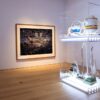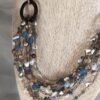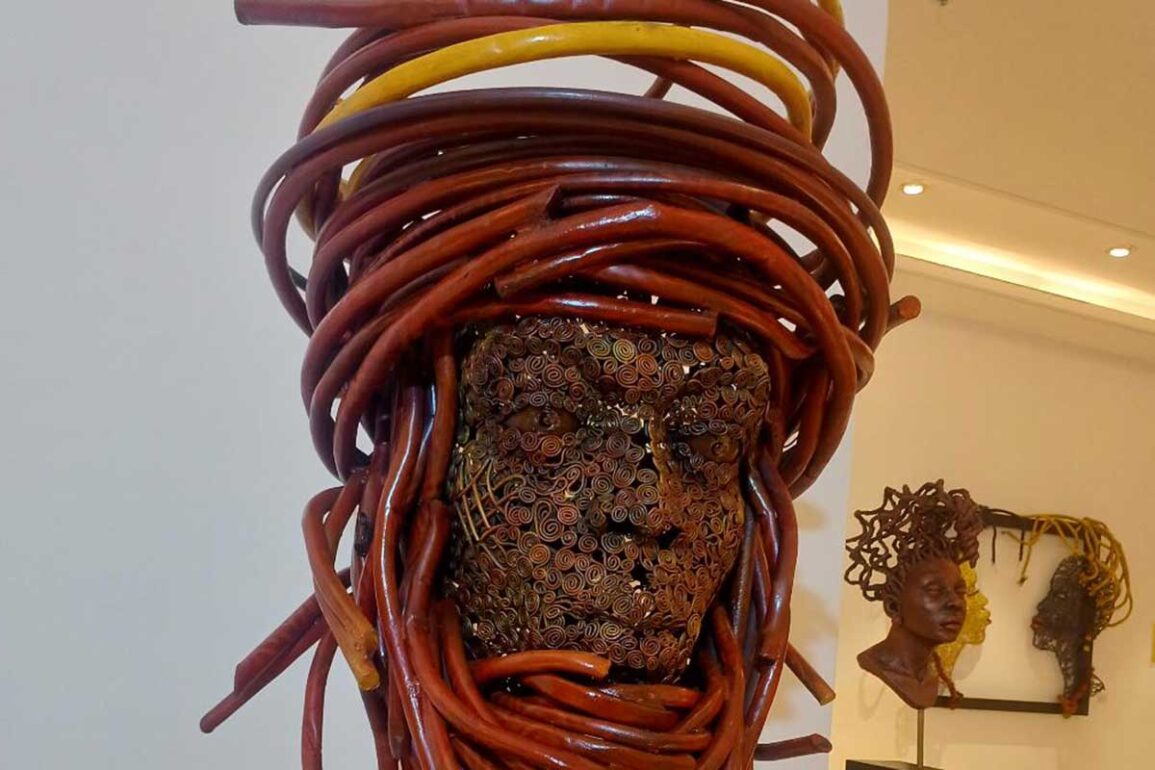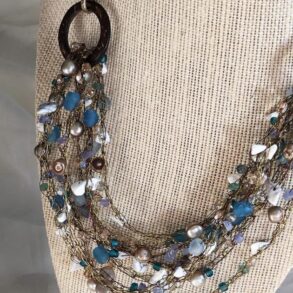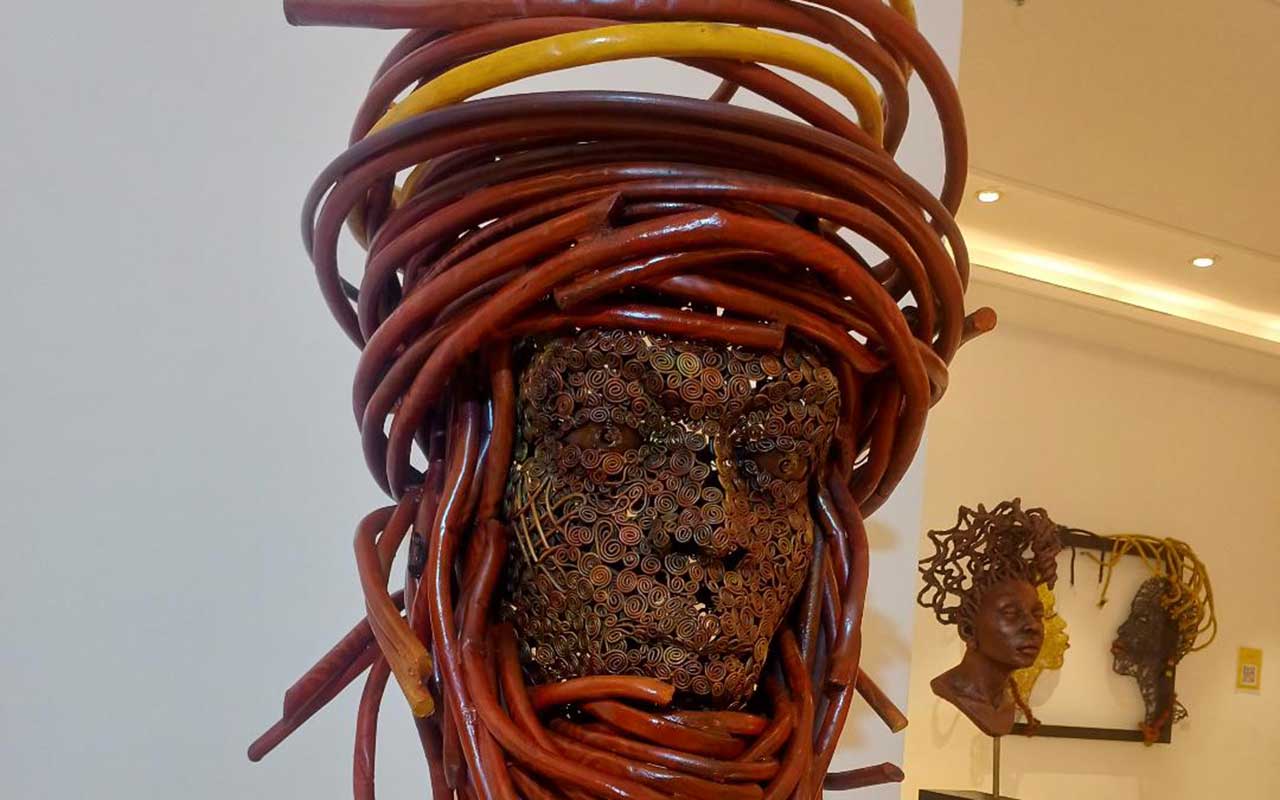
In living up to its reputation as a distinctive platform of adept art showcase, the 2024 edition of the Art Miabo International Arts Festival (AMIAF) interrogated the diverse realm of art and its creators and expanded beyond regular themes in the visual arts horizon.
The showcase indeed not only celebrated the craftsmanship of deserving sculptors but also engaged audience and encouraged personal interpretation of three-dimensional art forms in the themed ‘Sculptors Odyssey’.
Curator of the the 2024 edition, Yusuf Durodola, described the theme of AMIAF 2024 as “a celebration of the sculptor’s spirit – a testament to the transformative power of raw materials shaped by the artist’s hands, carving stories into stone, wood, metal, and imagination”.
As it was in its previous two editions, the AMIAF 2024, which ran from April 29 – May 1, 2024, at the EbonyLife Place, Victoria Island Lagos, celebrated the pivotal contributions of industry trailblazers, displaying their indispensable role in shaping the artistic landscape.
This year, four young sculptors were chosen to exhibit with established artists. They are: Ojegoke Pelumi, Azeez Kausarat, Blessing Proven and Ifeoluwa Odushe.
The four AMIAF Slot participants will be exhibiting with masters such as Pius Waritimi, Kunle Adeyemi, Adeola Balogun, Ato Arinze, Tonie Emodi, Dotun Popoola, Adeniyi Adewole, Aromire Wahab, Fidelis Eze Odogwu, Shola Kukoyi, Muraina Akeem, Adebisi Adebayo, Djakou Kassi Nathalie, Ibrahim Afegbua, Nkwocha Ernest, Luke Osaro, Adisa Juliet Nzekwe, Obinna Adiele and Ebriel Afegbua.
Other exhibiting artists include Nelson Edewor, Ayooluwa Akinrinola, Oladapo Afolayan, Tolulope Sobowale, Simon Chidiebere, Fatai Abdulkareem, Exodus Aluyia, Adebor Etsekhumhe, Abdulqadir Ojelade, Ugherebe Godwin, Hakim Dipeolu and Samuel Akintiitan.
AMIAF founder, Miabo Ngozi Enyadike, during a chat with The Guardian identified Artmiabo as an Art idea and the idea itself being sold as a brand advocates for every artist as an entrepreneur. “If you create something and you want people to admire and pay for it, then you’re selling. This is what I’ve done for years. I started selling art before I even started creating art. So, most collectors and people didn’t know I was an artist.
“Artmiabo is aimed at representing the unrepresented. That’s what i’ve experienced; I was refused every form of representation because of the way I paint. I paint on paper but with ink.” Miabo wants artists to open their minds to what art is to the world in today’s clime especially in the areas of representation, branding and market dynamics.
Already, Miabo defies traditional art representation by creating online galleries; she owns six virtual art galleries already.
Artist and entrepreneur, Miabo, emphasised on the importance of embracing unconventional paths in the 21st century art world. She highlighted the potential of the internet as a tool for artists to reach a wider audience and gain exposure, while acknowledging the challenges of navigating the art market and the need for authenticity and uniqueness in art.
Miabo noted the challenges and opportunities in the art market, including understanding market trends and investment fees, consistent performance, and strong collector base.
She also noted the relevance of female collectors and artists in the art world. First is the place of note of female collectors and their aggressive business approach to art, as well as women in the trade of art and their uncanny ability to make outstanding art traders. Women, she said, have the unique marketing skill in the trade especially with the ability of standing one’s ground in negotiations.
She said the challenges faced by women in the art world remain, including navigating gender roles and societal expectations, and the need for a support system in the art world and workplace.
Citing personal experiences and societal issues, Miabo advocated for unique perspectives through grid-inspired paintings.
Elaborating on art investment and market trends, she urged the need for authenticity of African art, the importance of exposure for collectors, education and expertise in business, social media in business, performance in managing collectors and making sales then collectors’ exhaustion and investment trends in the art market.
During a panel discussion, Dotun Popoola, a contemporary artist who specializes in synergetic metal sculpting, lent his experience on how artists and curators can blend up the traditional with the digital system of brand & marketing.
Dotun stated that an artist must be vast enough to know what the market is saying with keen comprehension of the psycho dynamics of art enterprise.
He said: “An artist must present his work with the right value that speaks to the appreciation of his brand.”
On the question of whether artists should study market algorithms in concerned climes before art endeavors, he said in the end, it all depends on the artist, his creative leanings, philosophy and business mindset. On his part, he has chosen certain unusual approaches in response to the demands of business in art. For example, Popoola would restrict collector’s number of acquisitions where his works are concerned.
“Although demand could determine what an artist produces, however, if an artist wants to be truly successful in life, you must do something that gives you the joy of it and that can go beyond the money you get for the work. The passion needs to be put in the right place.
“I don’t allow my client tell me where to weld a scrap. Just tell me what you want and I’ll manifest the idea my own way. That’s way, you as an artist can preserve your originality,” Popoola said.
Prince Yemisi Adedoyin Shyllon, elaborating on categorisation in art pricing and artists in societal artistic class, described Popoola as an artist who has been able to segment himself to meet the artistic needs of the upper echelon of the society and young or budding artists who take that route before mastery would starve.
Prince Shyllon is currently regarded as Nigeria’s largest private art collector, with over 7,000 artworks of sculptures, paintings and other media, as well as over 55,000 photographic shots of Nigeria’s cultural festivals.
In his clarification of market segmentation, he made reference to the Toyota example of Luxury Export to the United States (Lexus) and referred to the likes of Popoola as the Lexus of his time.
He said the pricing theory is clear for the artist including artists just fresh from school. The technique applicable is Cost Plus Pricing. He explained that what determines the price of an artwork is the reputation of the artist.
In his follow up with a recommendation that art business should be included in school curriculum, Prince Shyllon urged that art students should be taught marketing in the arts. He said the impartation of critical knowledge in the fields of marketing and art history is poor in Nigerian school curriculum.
“School institutions should encourage interactions between the ‘Gown’ with the ‘Town”, he said.
He also advocated for periodic invitations of professionals to classrooms for benefit of students. Another area he advocated is for copyright law and patent to be taught to artists in schools.
International Media Strategist and AMIAF patron, Emeka Enyadike stressed on the importance of specialization in business. He noted that no matter what field a person acquired knowledge or venture in by course of study, specialisation is pertinent.
“If for example you apply for a job in some museums, you won’t just be employed because you have a degree in Fine Arts, people have specialization in the art business. If you’re not prepared for the market, you may not be useful. This applies to almost all sectors including sports and engineering”.
Enyadike agreed that the understanding of marketing dynamics is critical for an artist. He described marketing as a very complicated field because it is visual. An artist has to be visual in creative approach. You have to be able to create something that can get the attention of people.
“There’s something called strategic fix. There has to be some concept around what you are doing. Even if you have a specialty, a title or theme for a work of art, there must be a way to align what you’re trying to do with the critical need of the target audience. There has to be a marriage between your goals and the goal of your target audience”
One of the master exhibitors, Dr. Adeola Balogun, Lecturer in the Fine Arts Department of the Yaba College of Technology, acknowledged the importance of the business side of the art venture or practice. “Unfortunately, most artists have been less inclined to scope of the enterprising area of art, especially marketing”, he noted.
He recalled the submission of another master exhibitor in the festival, Pius Waritimi, who during the panel discussion on Day 1 admitted to have ignored the business side of his artistry earlier in life. Waritimi said if he had been less conservative in his creative life, he would have made critical levels of expansion through his creative interests and craft.
Dr. Kunle Adeyemi, Director of Internal Quality Assurance (IQA) Department for Yaba College of Technology and a master exhibitor also in the festival, regarded the 2024 AMIAF as unique in initiative.
If galleries and stakeholders are able to put in like efforts into the arts, the impact will resound across the economy. He appreciated the aspect of specialization notable in the festival. The focus on sculptor and sculpture works was stressed as appreciative for the genre and the enlargement of the coast of sculptors in the country.
He noted the quality of creative endeavors in the field where sculptors have been able to expand their artistic effort into metal, bronze, fibre glass etcetera.. Adeyemi pressed for more specialized exposure for artists and the needed platform for development and enabling environment for more opportunities.
Art collectors and enthusiasts filled the VIP exhibition space of the festival in appreciation of the various works in display. One of such enthusiasts is Lucie Minlend, who expressed her interest in a few works, including that of one of the younger artists, Ibrahim Afegbua. His amazingly crafted metal art work in depiction of the beauty and appreciation of womanhood, caught the interest of Lucie. Lucie took specific note of the artists attention to the hair and the three dimensional portrayal of feminity.
Lucie, a US based francophonie Cameroonian, in her view of arts appreciation in Nigeria, noted the expressive nature of Nigerian art. Having seen several exhibitions in the United States and Europe, she said she could much easily relate with Nigerian art than the European.
She noted that the traditional rooting and detailing in Nigerian art, in contrast with other foreign art, stands it out and Nigerian artists show maintain their cultural identity in the uniqueness of their artistry. Despite the infusion of tech bits in classified modern art, identity and traditional details will always matter when it comes to African works of art. Without the distinction, the essence is lost, Lucie told The Guardian.
As a yearly large scale exhibition, AMIAF made its debut and second editions at the same venue when it showcased over 24 artists from within and outside Africa in 2022 and 2023 respectively. A special feature during the three-day 2024 edition was the musical performance of Afrobeat singer, Madè Kuti, son of international Afrobeat sensation Femi Kuti.
Made Kuti’s performance was most notable for the uniqueness of his performance and creative acoustic combo in delivery. Outstandingly, the multi-instrumentalist played seven different instruments in single rendition. The highlight of the performance was perhaps the infamous single note circular breathing technique he applied while playing the saxophone as he swayed with the blend of jazz, funk and West African folk rhythms.
During his chat with The Guardian, he disclosed that he has something hot in the works and would soon reveal.

